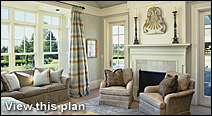Gas Fireplaces
 Consumers are all fired up about gas fireplaces. In fact, gas fireplaces are one of the most sought-after home features in new home construction, because they can be placed in almost any room in your new home and come in a wide range of sizes and styles.
Consumers are all fired up about gas fireplaces. In fact, gas fireplaces are one of the most sought-after home features in new home construction, because they can be placed in almost any room in your new home and come in a wide range of sizes and styles.
Today's gas fireplaces offer great options for architects and designers to showcase a room, while adding significant value to the home's resale value. One of the big attractions to gas fireplaces is they add ambiance and warmth to a room, while looking realistic. Another benefit is that they are more affordable and energy-efficient than a wood fireplace and are easy to operate and maintain.
Homeowners particularly like that don't have to store or haul wood, worry about insects or struggle with starting a fire, because with a gas fireplace it only takes a flip of the switch.
Some Key Considerations:
- Many gas fireplaces qualify as heating appliances, offering not just beauty but functionality.
- An excellent alternative heat source, particularly to warm a basement or extend the usability of your outdoor living space.
- In a well insulated home, a gas fireplace will allow you to lower you main heat by several degrees.
There are two basic models of gas fireplaces, the direct-vent and vent-free units:
Direct-vent units represent the majority of gas fireplace sales. They pose no indoor environmental concerns, but they must be located relatively close to an outside wall, Don says.
Vent-free units don't require venting to the outside, which makes these units a bit controversial. Some in the industry say that they are safe as long as they are well-maintained and used properly, while others insist that since they have no venting, they pose a threat to indoor air quality and safety. Be aware that some states don't permit the installation of vent-free fireplaces.
If gas fireplaces strike you as being low-tech, take a look at some of the recent innovations, which offer positive features in both aesthetics and comfort:
- Realistic flames resembling natural cord-wood fires, complete with glowing embers at the base
- Durable, authentic-looking artificial logs and flame control
- Blowers, often located behind the mantle, that push warm air in the room
- Automatic control by thermostat, timer or wall-mounted or remote control
- Since there is no chimney needed, direct-vent fireplace allow placement of windows directly over the mantel
The trend is for unique designs and styles in fireplaces. Each manufacturer is trying to outdo the other. You'll in find fireplaces that resemble a picture frame on a wall or are mounted over a television; in glass cylinders that look like an eternal flame in the living room, and even in elaborate displays that combine fire with water.



.png)
.png)


